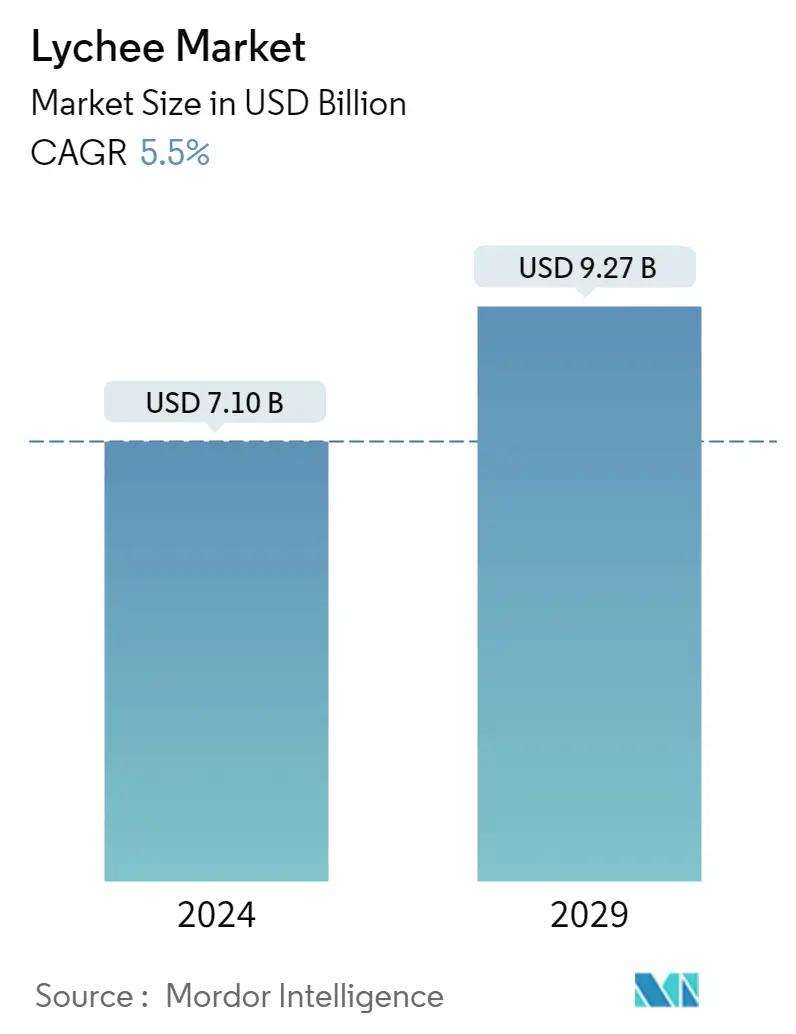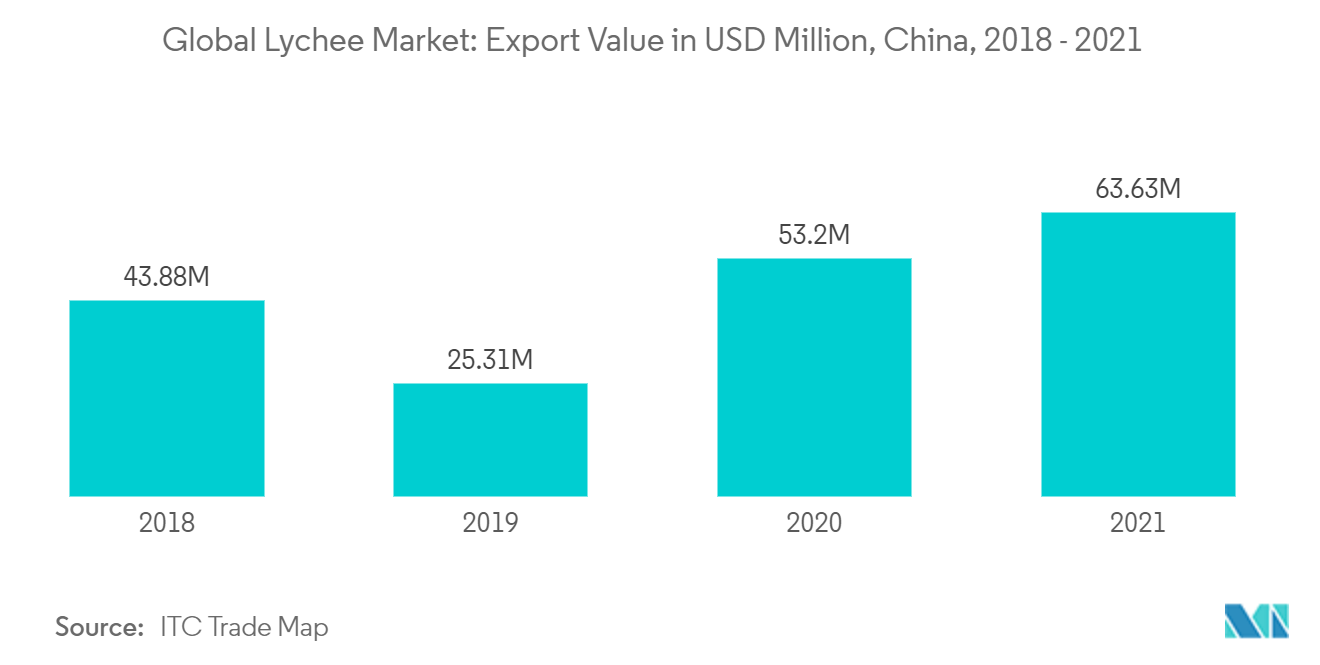Lychee Market Size

| Study Period | 2019 - 2029 |
| Market Size (2024) | USD 7.10 Billion |
| Market Size (2029) | USD 9.27 Billion |
| CAGR (2024 - 2029) | 5.50 % |
| Fastest Growing Market | Asia-Pacific |
| Largest Market | Asia-Pacific |
Major Players*Disclaimer: Major Players sorted in no particular order |
Lychee Market Analysis
The Lychee Market size is estimated at USD 7.10 billion in 2024, and is expected to reach USD 9.27 billion by 2029, growing at a CAGR of 5.5% during the forecast period (2024-2029).
- The market for lychee is growing because people in emerging and developing countries around the world want more fresh food.Favorable government initiatives and rising trade from the significant producers drive the market's growth. The need for products like jam, juice concentrates, canned lychee, dried lychee, etc. is also increasing. At the end of 2019, Vietnam entered an agreement with lychee farmers to export lychees to Japan.
- China is a major producer and exporter of lychees, with a large share of the world market for lychee exports.According to the ITC Trade Map, the total fresh lychee export from China was worth USD 63.6.2 million in 2021. Neighboring Asian countries and the United States are China's major markets for lychee exports. European consumers consider lychee a 'sweet, nutritious' super fruit, which also drives the large volume of lychee exports to countries like the Netherlands and the United Kingdom.
- The export of lychee has considerably increased over the years, mainly because of the increasing demand for healthy food in these markets. According to data from the General Administration of Customs of China (GACC), Guangdong province exported 5,902.1 metric tons of lychee in 2020, showing an increase of 72.3% in comparison to 2019.
- Lychee production is mostly in the Asia-Pacific region. China, Vietnam, India, Taiwan, and other Southeast Asian countries are the main countries that make lychees. Lychee from Madagascar occupies a strong position in the European market. Hence, the rising demand and favorable government support are expected to significantly boost market growth in the coming years.
Lychee Market Trends
This section covers the major market trends shaping the Lychee Market according to our research experts:
Increasing Demand from International Markets
Consumers are becoming more aware of health issues and conscious about their diet. Lychees are well known for being healthy fruits. Lychee is a specialty fruit that is slowly gaining popularity in Europe, although average consumption per capita is still limited. The fruit is gaining popularity in France as well. Consumption of sustainably produced fresh fruit offers greater opportunity in Europe.
The rising demand for lychee in France and other EU countries is expected to boost lychee imports further in the coming years. Thus, the demand for lychee in many countries is increasing tremendously with each passing year. The exports to international markets, along with domestic consumption, are expected to grow during the forecast period.
Lychee is becoming more popular in the perfume, skin care, and hair care industries, as well as in the cosmetics and fragrances industries.The growing HORECA industry in the United States, which serves continental food, is driving up demand for the fruit.The lychee fruit is now finding its way into supermarkets across Canada. The majority of the consumption is based on importing the fruit from neighboring countries and Asian countries. Litchis are consumed in salads, ice creams, custards, and other desserts by the Canadian population.
China is the leading exporter of lychee fruit. The country had exported lychee fruit worth USD 63.3 million in 2021, with the main destinations being Hong Kong, Singapore, the United States, Indonesia, the Philippines, and Malaysia.

Expanding Lychee Market in the Asia-Pacific Region
Lychee is primarily produced in China and India. China is the main producer of lychees, followed by India and other countries in Southeast Asia. According to the International Society for Horticultural Science (ISHS), in 2019, Southeast Asian countries accounted for 19% of the lychee market. Madagascar accounted for 35% of the global exports, followed by Vietnam and China with 19% and 18%, respectively.
Lychee is one of the prominent fruits grown in India. In India, the government and private companies have been taking initiatives to boost value addition, exports, and the value realization of farmers. For instance, in 2020, Coca-Cola India, DeHaat, the National Research Center on Litchi (NRCL), and Kedia's fresh partner launched an initiative called Unnati Litchi. The initiative is aimed at enhancing the efficiency of the agri-value chain and farmers' capabilities by building on high-density plantations, farmer training for good agriculture practices (GAP), and the creation of demo orchards through appropriate technology interventions. Thus, the aforementioned factors are driving the market, which is anticipated to grow during the forecast period.
According to horticulture statistics, the area of cultivation under lychee was 96,000 hectares in 2019. Similarly, lychee production was at 686,450.0 metric tons in 2017, and it increased to 720,980.0 metric tons by 2021. Directorate General of Commercial Intelligence and Statistics (DGCIS) says that Nepal, the United Arab Emirates, the United Kingdom, and Bhutan are the top places where India sends lychee.The export quantity increased by almost 80% from 2017 and reached 193.8 metric tons in 2021.
The Agricultural and Rural Department of Guangdong Province says that Guangdong, which has more than one-third of the world's planting area, will have a big harvest in 2020. The exports increased substantially. By June 2020, the Guangdong province exported around 4,000 metric tons of lychee, leading to a 20% year-on-year increase. Based on the figures from ITC TradeMap, the total export value of lychee from China in 2020 was USD 53.19 million, which increased by almost 20%, reaching USD 63.6 million in 2021. The major importing countries from China are Hong Kong, Singapore, Indonesia, and the Philippines. China's exports to Hong Kong and Singapore in 2021 will be significantly higher than in 2017. In 2017, the export value from Singapore was USD 0.34 million, and it rose to USD 7.6 million in 2021.

Lychee Market News
- August 2022: Scientists at South China Agriculture University School of Horticulture made the world's first longan/lychee hybrid, Cineworld's SZ52, and it's expected to have characteristics suited for commercialization and wide scale adoption.
- June 2022: The Agricultural and Processed Food Products Export Development Authority (APEDA), along with Bihar Fruit & Vegetable Development Corporation (BFVDC), set up a virtual meeting with international importers and exporters and plant suppliers to promote Bihar's 'Langara aam' and 'Shahi litchi" in overseas markets like Mauritius, New Zealand, Bahrain, Qatar, the UK, and the UAE.
Lychee Market Report - Table of Contents
1. INTRODUCTION
- 1.1 Study Assumptions and Market Definition
- 1.2 Scope of the Study
2. RESEARCH METHODOLOGY
3. EXECUTIVE SUMMARY
4. MARKET DYNAMICS
- 4.1 Market Overview
- 4.2 Market Drivers
- 4.3 Market Restraints
- 4.4 Value Chain Analysis
5. MARKET SEGMENTATION (Production Analysis, Consumption Analysis, Import Market Analysis by Value and Volume, Export Market Analysis by Value and Volume, and Price Trend Analysis)
-
5.1 North America
- 5.1.1 United States
- 5.1.2 Canada
-
5.2 Europe
- 5.2.1 United Kingdom
- 5.2.2 France
- 5.2.3 Germany
- 5.2.4 Spain
- 5.2.5 Netherlands
-
5.3 Asia-Pacific
- 5.3.1 China
- 5.3.2 India
- 5.3.3 Thailand
- 5.3.4 Vietnam
-
5.4 Africa
- 5.4.1 South Africa
- 5.4.2 Madagascar
6. MARKET OPPORTUNITIES AND FUTURE TRENDS
** Subject To AvailablityLychee Industry Segmentation
Lychee is the sole member of the genus Litchi in the soapberry family, Sapindaceae, grown for its edible fruit. For analysis, only fresh produce is considered, and any form of processed produce is excluded from the scope. The lychee market is segmented by geography (North America, Europe, Asia-Pacific, and Africa). The report provides an analysis of production (volume), consumption (volume and value), import (volume and value), export (volume and value), and price trend analysis. The report offers the market size and forecasts for value (USD million) and volume (metric ton) for all the above segments.
| North America | United States |
| Canada | |
| Europe | United Kingdom |
| France | |
| Germany | |
| Spain | |
| Netherlands | |
| Asia-Pacific | China |
| India | |
| Thailand | |
| Vietnam | |
| Africa | South Africa |
| Madagascar |
Lychee Market Research FAQs
How big is the Lychee Market?
The Lychee Market size is expected to reach USD 7.10 billion in 2024 and grow at a CAGR of 5.5% to reach USD 9.27 billion by 2029.
What is the current Lychee Market size?
In 2024, the Lychee Market size is expected to reach USD 7.10 billion.
Which is the fastest growing region in Lychee Market?
Asia-Pacific is estimated to grow at the highest CAGR over the forecast period (2024-2029).
Which region has the biggest share in Lychee Market?
In 2024, the Asia-Pacific accounts for the largest market share in Lychee Market.
What years does this Lychee Market cover, and what was the market size in 2023?
In 2023, the Lychee Market size was estimated at USD 6.73 billion. The report covers the Lychee Market historical market size for years: 2019, 2020, 2021, 2022 and 2023. The report also forecasts the Lychee Market size for years: 2024, 2025, 2026, 2027, 2028 and 2029.
Litchi Industry Report
Statistics for the 2024 Litchi market share, size and revenue growth rate, created by Mordor Intelligence™ Industry Reports. Litchi analysis includes a market forecast outlook to 2029 and historical overview. Get a sample of this industry analysis as a free report PDF download.



